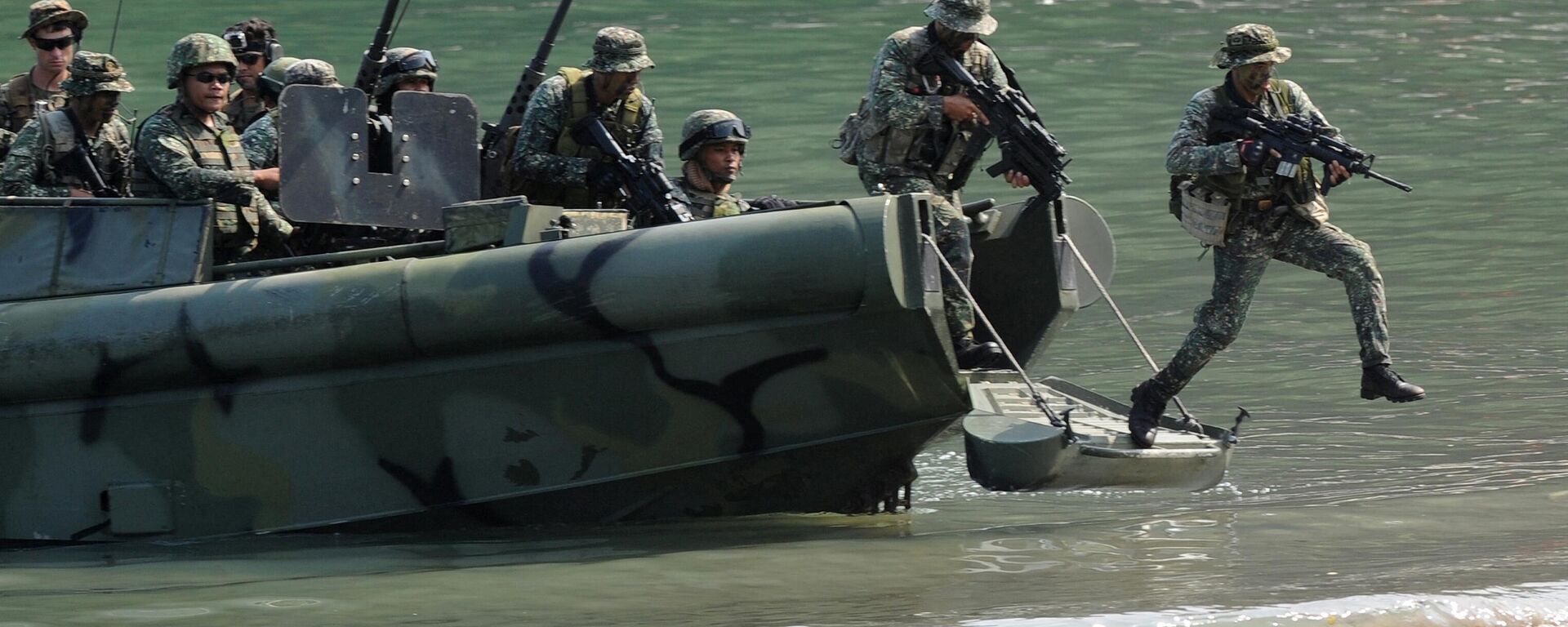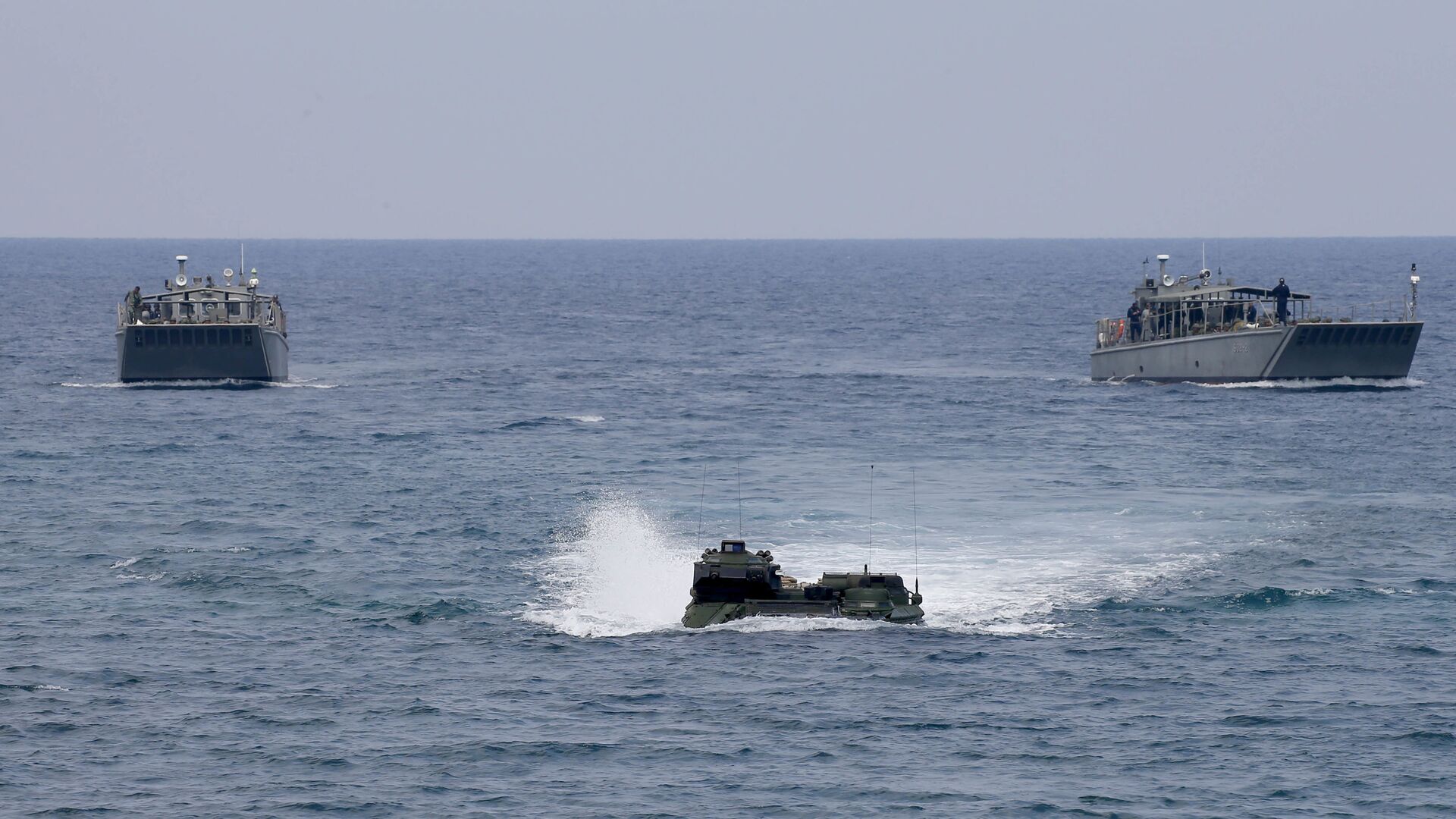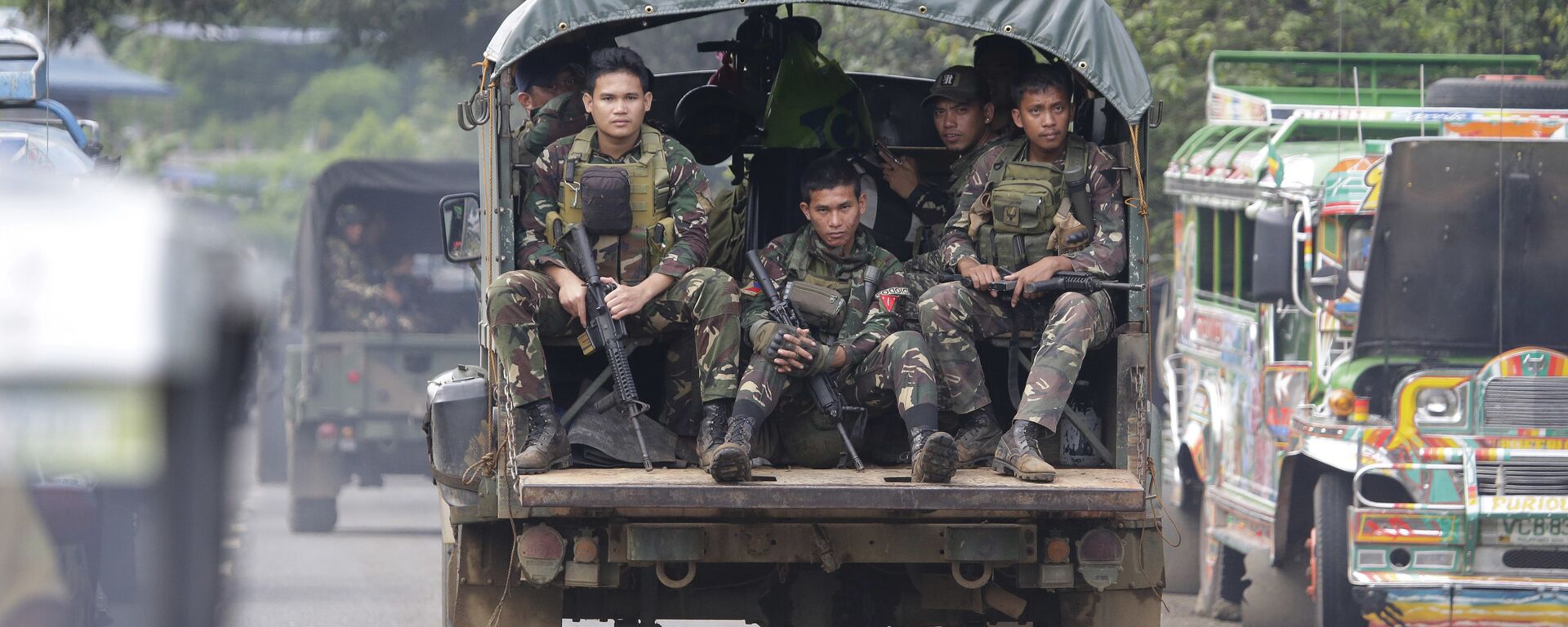https://sputnikglobe.com/20230405/us-pulls-philippines-into-natos-geopolitical-confrontation-versus-china-1109119777.html
US Pulls Philippines Into NATO's Geopolitical Confrontation Versus China
US Pulls Philippines Into NATO's Geopolitical Confrontation Versus China
Sputnik International
In April, US military units could be deployed to new Philippine-owned bases. An expanded US military presence in the Philippines would allow the US to respond to the situation around Taiwan from the south. The US threatens peace and stability in the South China Sea, which China finds unacceptable.
2023-04-05T04:15+0000
2023-04-05T04:15+0000
2023-04-05T04:15+0000
world
us
china
philippines
nato
https://cdn1.img.sputnikglobe.com/img/07e4/08/02/1080040677_0:49:3465:1998_1920x0_80_0_0_91b3af3a95465b75d53358cedd940dce.jpg
The joint Philippines-US Balikatan-2023 military exercises will be held all across the Philippines, the US Embassy in Manila announced on Tuesday. The announcement confirmed that the exercise will be held from April 11 to 28, and will be the largest ever. More than 5,000 Philippine Army troops and more than 12,000 American soldiers will participate this year. Last year's exercise involved about 9,000 troops.Live-fire exercises are another feature of the upcoming drills, as previously announced by the Philippine organizers. Participants in the maneuvers will also conduct amphibious and airborne operations, cyber defense, counterterrorism, and humanitarian assistance training.The US Embassy announced that the exercise would take place throughout the Philippines a day after the Philippine government announced the deployment of four new military bases where US military units will be allowed to be stationed on a rotational basis. This brings the number of such facilities to nine. Most likely the Americans are already planning to train and then leave the first groups of soldiers and military equipment at the new sites during the Balikatan-2023 exercises.The approval for these four facilities was likely personally pushed through by first US Vice President Kamala Harris and then Secretary of Defense Lloyd Austin during their trips to the Philippines. This took about five months. The haste of the Americans can be explained by the fact that the new facilities include the Philippine naval base in Santa Ana and the Cagayan North International Airport in Lal-lo, both in the northern province of Cagayan, close to Taiwan and the south of mainland China. The Americans will also be stationed at a base in the northern province of Isabela and a naval camp on Balabac Island in the western province of Palawan.The presence of the new Philippine military facilities will increase the potential of US military influence on the situation in the Taiwan Strait and the South China Sea, Chen Xiangmiao, expert of the China Institute of the South China Sea, told Sputnik:“The possible deployment of US troops to four new Philippine bases will expand the US military presence near the South China Sea as part of its Indo-Pacific strategy. One of the US' strategic intentions is to build a forward operating base on Balabac Island. Balabac Island faces the Nanshan Islands, which are being developed by China. Therefore, the US intention to use this island as an outpost is obvious. It is important for increasing US intelligence activities or military pressure on China and other states in the South China Sea basin. The establishment of a multidisciplinary base on Balabac for the integrated deployment of US naval and air forces could provide future logistical support and resupply to US forces for military operations throughout the region. Three other new bases could be used primarily by the US military to respond to the Taiwan Strait situation from the south. From the north, the Americans have support for their plans in the region from the nearby islands of Japan. Thus, the new bases in the Philippines will fill the gap in the south, which is important for the US strategy.”The US is trying to drag the Philippines into a confrontation with China, Konstantin Sivkov, a military analyst and deputy president of the Russian Academy of Missile and Artillery Sciences, told Sputnik:China has already sent a message to the Philippines not to allow a third party to undermine the friendly relations between the two countries. This was said by Wang Yi, director of the Office of the Foreign Affairs Commission of the Communist Party of China Central Committee, in a meeting in Beijing on Monday with former Philippine President and Senior Deputy Speaker of the Philippine House of Representatives Gloria Macapagal Arroyo. The top Chinese official urged the Philippines to remain committed to properly resolving differences through communication and dialogue.China will not ignore a possible change in the balance of power in this region in favor of the US, Professor Dmitry Mosyakov, head of the Center for Southeast Asia, Australia, and Oceania at the Institute of Oriental Studies of the Russian Academy of Sciences, told Sputnik.The US intention to obtain military bases in the Philippines runs counter to the China-ASEAN consensus on maintaining peace and stability in the South China Sea. Commenting on the US military's access to several facilities in the Philippines, Chinese Foreign Ministry spokeswoman Mao Ning said at a briefing on Tuesday that regional countries should "think deeply" about what is mutually beneficial cooperation for them to make the right choice that truly meets their own interests. The US has been steadily increasing its military presence in Southeast Asia based on its own interests. The result will inevitably be an increase in tensions, the Chinese diplomat said.
https://sputnikglobe.com/20230313/philippines-us-kick-off-joint-military-drills-with-up-to-3000-soldiers-1108345669.html
https://sputnikglobe.com/20230216/why-is-the-us-militarizing-the-philippines-1107506192.html
china
Sputnik International
feedback@sputniknews.com
+74956456601
MIA „Rossiya Segodnya“
2023
Sputnik International
feedback@sputniknews.com
+74956456601
MIA „Rossiya Segodnya“
News
en_EN
Sputnik International
feedback@sputniknews.com
+74956456601
MIA „Rossiya Segodnya“
Sputnik International
feedback@sputniknews.com
+74956456601
MIA „Rossiya Segodnya“
us military units, new philippine-owned bases, us military presence in the philippines
us military units, new philippine-owned bases, us military presence in the philippines
US Pulls Philippines Into NATO's Geopolitical Confrontation Versus China
In April, US military units could be deployed to new Philippine-owned bases. An expanded US military presence in the Philippines would allow the US to respond to the situation around Taiwan from the south. The US threatens peace and stability in the South China Sea, which China finds unacceptable.
The joint Philippines-US Balikatan-2023 military exercises will be held all across the Philippines, the US Embassy in Manila announced on Tuesday. The announcement confirmed that the exercise will be held from April 11 to 28, and will be the largest ever. More than 5,000 Philippine Army troops and more than 12,000 American soldiers will participate this year. Last year's exercise involved about 9,000 troops.
Live-fire exercises are another feature of the upcoming drills, as previously announced by the Philippine organizers. Participants in the maneuvers will also conduct amphibious and airborne operations, cyber defense, counterterrorism, and humanitarian assistance training.
The US Embassy announced that the exercise would take place throughout the Philippines a day after the Philippine government announced the deployment of four new military bases where US military units will be allowed to be stationed on a rotational basis. This brings the number of such facilities to nine. Most likely the Americans are already planning to train and then leave the first groups of soldiers and military equipment at the new sites during the Balikatan-2023 exercises.
The approval for these four facilities was likely personally pushed through by first US Vice President Kamala Harris and then Secretary of Defense Lloyd Austin during their trips to the Philippines. This took about five months. The haste of the Americans can be explained by the fact that the new facilities include the Philippine naval base in Santa Ana and the Cagayan North International Airport in Lal-lo, both in the northern province of Cagayan, close to Taiwan and the south of mainland China. The Americans will also be stationed at a base in the northern province of Isabela and a naval camp on Balabac Island in the western province of Palawan.
The presence of the new Philippine military facilities will increase the potential of US military influence on the situation in the Taiwan Strait and the South China Sea, Chen Xiangmiao, expert of the China Institute of the
South China Sea, told Sputnik:
“The possible deployment of US troops to four new Philippine bases will expand the US military presence near the South China Sea as part of its Indo-Pacific strategy. One of the US' strategic intentions is to build a forward operating base on Balabac Island. Balabac Island faces the Nanshan Islands, which are being developed by China. Therefore, the US intention to use this island as an outpost is obvious. It is important for increasing US intelligence activities or military pressure on China and other states in the South China Sea basin. The establishment of a multidisciplinary base on Balabac for the integrated deployment of US naval and air forces could provide future logistical support and resupply to US forces for military operations throughout the region. Three other new bases could be used primarily by the US military to respond to the Taiwan Strait situation from the south. From the north, the Americans have support for their plans in the region from the nearby islands of Japan. Thus, the new bases in the Philippines will fill the gap in the south, which is important for the US strategy.”
The US is trying to drag the Philippines into a confrontation with China, Konstantin Sivkov, a military analyst and deputy president of the Russian Academy of Missile and Artillery Sciences, told Sputnik:
“This is an anti-Chinese action that threatens China's border security and interests. For the Americans, the Philippines is an important springboard for action against China in the South China Sea and the Taiwan Strait. China is likely to retaliate militarily, including by building up its forces in the south. It will seek to minimize emerging threats. Meanwhile, tensions in the waters adjacent to the Philippines are bound to rise, which could lead to a sharp deterioration in Sino-Philippine relations.”
China has already sent a message to the
Philippines not to allow a third party to undermine the friendly relations between the two countries. This was said by Wang Yi, director of the Office of the Foreign Affairs Commission of the Communist Party of China Central Committee, in a meeting in Beijing on Monday with former Philippine President and Senior Deputy Speaker of the Philippine House of Representatives Gloria Macapagal Arroyo. The top Chinese official urged the Philippines to remain committed to properly resolving differences through communication and dialogue.

16 February 2023, 14:32 GMT
China will not ignore a possible change in the balance of power in this region in favor of the US, Professor Dmitry Mosyakov, head of the Center for Southeast Asia, Australia, and Oceania at the Institute of Oriental Studies of the Russian Academy of Sciences, told Sputnik.
“China is making serious efforts to counter the threat to its security. It is fortifying the artificial islands (in the South China Sea). These are virtually unsinkable aircraft carriers, a very serious and important aid to maritime interests. China is accelerating the construction of a 'blue-water' fleet, an ocean fleet. The US has put a lot of pressure on the president of the Philippines. It's important for the US to use that country as an outpost to block Chinese ships' access to the open ocean. The Americans are now trying with all their might to create a semblance of a military bloc in Asia. Nothing works with the Quad, AUKUS is still a distant prospect. Only the advent of NATO can really have a dramatic effect on the situation there. NATO, with all its infrastructure, plans, and programs is really dangerous to Asian security. The Americans are now apparently preparing this infrastructure in the Philippines, perhaps not so much for the Americans as for NATO forces.”
The US intention to obtain military bases in the Philippines runs counter to the
China-ASEAN consensus on maintaining peace and stability in the South China Sea. Commenting on the US military's access to several facilities in the Philippines, Chinese Foreign Ministry spokeswoman Mao Ning said at a briefing on Tuesday that regional countries should "think deeply" about what is mutually beneficial cooperation for them to make the right choice that truly meets their own interests. The US has been steadily increasing its military presence in Southeast Asia based on its own interests. The result will inevitably be an increase in tensions, the Chinese diplomat said.




